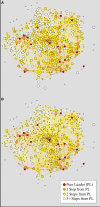Diffusion of a Peer-Led Suicide Preventive Intervention Through School-Based Student Peer and Adult Networks
- PMID: 30498462
- PMCID: PMC6249330
- DOI: 10.3389/fpsyt.2018.00598
Diffusion of a Peer-Led Suicide Preventive Intervention Through School-Based Student Peer and Adult Networks
Abstract
Background: Peer-led interventions have been applied to prevent various health behavior problems and may be an important complement to individual-level suicide prevention approaches. Sources of Strength trains student "peer leaders" in secondary schools to conduct prevention activities that encourage other students to build healthy social bonds and strengthen help-seeking norms. Prior work examining diffusion of peer-led programs has focused on youths' closeness to peer leaders but minimally on other factors such as connections to adults and suicidal behavior. Methods: We examined implementation and dissemination of Sources of Strength in 20 schools. Over 1 year 533 students were trained as peer leaders and 3,730 9th-12th graders completed baseline surveys assessing friendships and adults at school, and suicidal thoughts/behaviors; and end-of-year surveys reporting intervention exposure: viewed poster/video, attended presentation, direct peer communication, and activity participation. Chi-square tests compared exposure rates by student and network characteristics. Multi-level logistic regression models tested predictors of exposure across individual and school-level characteristics. Results: Exposure to the intervention varied greatly by school and by individual student characteristics and network position. Training more peer leaders increased school-wide exposure for all modalities except presentation (Bs 0.06-0.10, p's < 0.05). In multivariate models, exposure was consistently higher for students closer to peer leaders in the friendship network (ORs 1.13-1.54, p's < 0.05) and students who named more trusted adults (ORs 1.08-1.16, p's < 0.001); and lower for males (ORs 0.56-0.83, p's < 0.05). In multivariate models, training more students as peer leaders predicted exposure to poster-video and direct peer communication in larger schools (OR = 3.34 and 2.87, respectively). Network characteristics influenced exposure similarly for students with suicidal thoughts and behaviors. Discussion: Our findings confirm prior work showing the importance of personal affiliations to peer leaders and natural networks as a medium for diffusion of peer-led prevention efforts. We build on that work by showing independent effects of closeness to adults at school and number of peer leaders trained. There is a need to strategically select peer leaders to maximize closeness to students school-wide, particularly in larger schools. Additional work is required for Sources of Strength to devise messaging strategies to engage males and students isolated from adults at school.
Keywords: diffusion of innovations; peer leaders; peer messaging; school intervention; social connectedness; social networks; social support; suicide prevention.
Figures





Similar articles
-
A comparison of peer change agent selection methods: Evidence from a high-school based suicide preventive intervention.BMC Public Health. 2022 May 16;22(1):985. doi: 10.1186/s12889-022-13372-w. BMC Public Health. 2022. PMID: 35578328 Free PMC article.
-
Peer-adult network structure and suicide attempts in 38 high schools: implications for network-informed suicide prevention.J Child Psychol Psychiatry. 2019 Oct;60(10):1065-1075. doi: 10.1111/jcpp.13102. Epub 2019 Aug 8. J Child Psychol Psychiatry. 2019. PMID: 31392720 Free PMC article.
-
An outcome evaluation of the Sources of Strength suicide prevention program delivered by adolescent peer leaders in high schools.Am J Public Health. 2010 Sep;100(9):1653-61. doi: 10.2105/AJPH.2009.190025. Epub 2010 Jul 15. Am J Public Health. 2010. PMID: 20634440 Free PMC article. Clinical Trial.
-
[What support of young presenting a first psychotic episode, when schooling is being challenged?].Encephale. 2017 Dec;43(6):570-576. doi: 10.1016/j.encep.2017.10.001. Epub 2017 Nov 8. Encephale. 2017. PMID: 29128195 Review. French.
-
Emotional Peer Support Interventions for Students With SEND: A Systematic Review.Front Psychol. 2021 Dec 28;12:797913. doi: 10.3389/fpsyg.2021.797913. eCollection 2021. Front Psychol. 2021. PMID: 35027905 Free PMC article.
Cited by
-
Social Ties Cut Both Ways: Self-Harm and Adolescent Peer Networks.J Youth Adolesc. 2019 Aug;48(8):1506-1518. doi: 10.1007/s10964-019-01011-4. Epub 2019 Apr 15. J Youth Adolesc. 2019. PMID: 30989471 Free PMC article.
-
Mechanisms of school-based peer education interventions to improve young people's health literacy or health behaviours: A realist-informed systematic review.PLoS One. 2024 May 31;19(5):e0302431. doi: 10.1371/journal.pone.0302431. eCollection 2024. PLoS One. 2024. PMID: 38820530 Free PMC article.
-
Accounting for Context in Randomized Trials after Assignment.Prev Sci. 2022 Nov;23(8):1321-1332. doi: 10.1007/s11121-022-01426-9. Epub 2022 Sep 9. Prev Sci. 2022. PMID: 36083435 Free PMC article.
-
Strategies and evaluation underpinning the implementation of suicide prevention training: a systematic review.BMC Public Health. 2025 Mar 6;25(1):889. doi: 10.1186/s12889-025-21999-8. BMC Public Health. 2025. PMID: 40050823 Free PMC article.
-
Educational agents and institutions called into action in suicide prevention, intervention, and postvention.Front Psychol. 2023 Sep 14;14:1213751. doi: 10.3389/fpsyg.2023.1213751. eCollection 2023. Front Psychol. 2023. PMID: 37780143 Free PMC article.
References
Grants and funding
LinkOut - more resources
Full Text Sources

